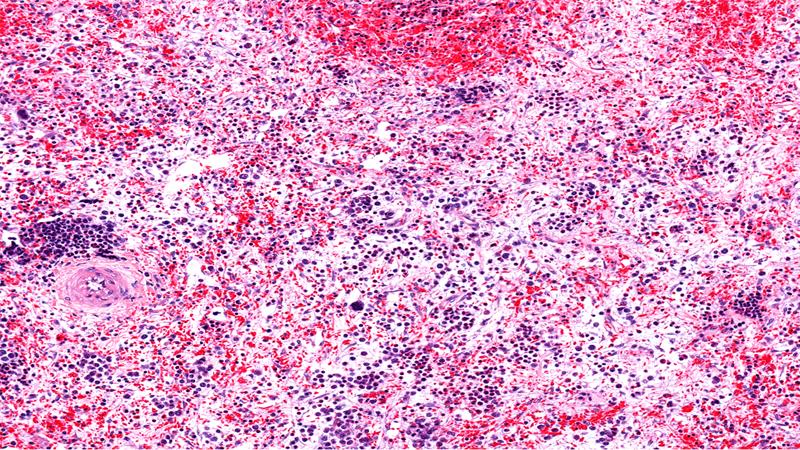Navitoclax–ruxolitinib combo doubles spleen response rates in myelofibrosis





In untreated myelofibrosis, using navitoclax in combination with ruxolitinib appears to result in a twofold increase in the number of patients experiencing spleen volume shrinkage, regardless of prognosis, according to updated data from the phase III TRANSFORM-1 trial.
At week 24, 63.2 percent of patients who received navitoclax plus ruxolitinib (combination arm) met the primary endpoint of at least a 35-percent reduction in spleen volume (SVR35) compared with only 31.5 percent of those who received placebo plus ruxolitinib (control arm), with the difference being “highly statistically significant” (p<0.0001), reported lead author Dr Naveen Pemmaraju from the University of Texas MD Anderson Cancer Center in Houston, Texas, US. [EHA 2024, abstract S222]
“Importantly, this was [observed] in a group of higher risk patients,” with more than 80 percent having intermediate-2 risk according to the DIPSS* Plus scoring system and nearly half having a high molecular risk mutation, continued Pemmaraju.
A similar trend was observed when looking at patients who achieved SVR35 at any time during the study (76.8 percent vs 43.3 percent; p<0.0001). This was consistent across multiple subgroups, including those defined by DIPSS Plus score, high molecular risk status, type of myelofibrosis, age, and baseline platelet count, among others.
Additional data showed that more patients in the combination arm than in the control arm achieved SVR35 as early as week 12 (62.4 percent vs 27.6 percent) and all the way out to week 48 (53.6 percent vs 26.8 percent), Pemmaraju noted. The same was true for the proportion of patients with at least a 50-percent spleen volume reduction (week 12: 24.0 percent vs 5.5 percent; week 48: 25.6 percent vs 11.0 percent).
“Therefore, [TRANSFORM-1] was a positive study with primary endpoint being met,” Pemmaraju said.
Other disease modification markers
Pemmaraju and colleagues examined other markers of disease modification. First was the variant allele frequency (VAF). “Here, we used the cutoff of 20 percent or greater [reduction],” he said.
At baseline, 70 percent of patients in the combination arm and 63 percent of those in the control arm had ≥50 percent VAF. A reduction of at least 20 percent at any time during the study was documented in 56.8 and 42.2 percent of patients in the respective arms.
Second was the progression free survival (PFS), which according to Pemmaraju was “a true emerging marker in our field, [and] one that I believe that we need to incorporate moving forward.”
PFS was longer among patients who did vs did not achieve ≥20 percent VAF reduction, regardless of treatment arm. The median PFS was 25.1 and 22.2 months, with 24-month PFS rates of 78.9 percent and 68.19 percent, respectively.
Finally, haemoglobin response was observed more frequently in the combination arm than in the control arm (34.4 percent vs 27.6 percent). Response was defined as ≥1.5 g/dL increase in haemoglobin from baseline without receiving any red blood cell transfusion within 2 weeks or erythropoietin supplementation within 4 weeks.
No significant symptom improvement
Meanwhile, symptom burden according to the total symptom score (TSS) at week 24 did not significantly differ between the treatment arms. The mean TSS change from baseline was –9.7 with the combination arm vs –11.1 with control arm (p=0.2852).
According to Pemmaraju, there are multiple factors at play for the lack of significant symptom improvement with the combination despite the doubling of the SVR35.
“One, I believe that when we invented the important patient-directed symptom score, this was in the Janus kinase (JAK) inhibitor monotherapy era, and the JAK/STAT pathway and those inhibitors are uniquely poised to improve symptoms. Second, when you introduce a second drug, by definition, we will increase the symptoms and toxicities,” Pemmaraju explained.
“I wonder if you can still have benefit more beyond the spleen and symptoms to show as we show here, PFS. My point and question to our field is, when a primary endpoint is met and SVR reduction is also met, perhaps we can find other markers beyond the symptoms that would be beneficial for our patients,” he said.
Safety
TRANSFORM-1 included 252 adults with intermediate-2 or high-risk JAK inhibitor-naïve myelofibrosis per DIPSS Plus, with measurable splenomegaly, and ECOG Performance Score ≤2. These patients were randomly assigned to receive placebo or navitoclax at either 200 mg/day starting dose (if platelet count >150 × 109/L) or 100 mg escalated to 200 mg/day (if platelet count ≤150 × 109/L), administered in combination with ruxolitinib at label dose. The median follow-up was 20.3 months.
Median age was 70 years in the combination arm (n=125) and 69 years in the control arm (n=127). More than half (57.1 percent) of the entire population were male, and 79 percent were White. Spleen volume at baseline was 1,441.4 cm3 in the combination arm and 1,639.0 cm3 in the control arm.
Changes in fatigue and physical functioning at week 24 were comparable between the treatment arms. Any adverse event (AE) occurred in 100 percent of patients in the combination arm and in 97.6 percent in the control arm. The most common AEs were thrombocytopenia (leading to dose interruption: 54.0 percent vs 13.6 percent; leading to dose reduction: 67.7 percent vs 28.0 percent), anaemia (63.7 percent vs 50.4 percent), diarrhoea (37.1 percent vs 15.2 percent), and neutropenia. Serious AEs occurred in 28.2 percent of patients with the combination and 38.4 percent with the control, with the most common being infections and infestations.
“No new safety signals were observed through 48 weeks, [and] dose reductions and interruptions were due to thrombocytopenia,” Pemmaraju noted.
“[TRANSFORM-1] really calls to action in our field of myeloproliferative neoplasms to look at further markers of disease modification and further evaluations to our response criteria. Perhaps now is the time, in the beyond-JAK inhibitor era, to look at markers beyond spleen and symptoms, including PFS, VAF reduction, modulation of high molecular risk factors, and other markers,” he said.
Navitoclax is an orally bioavailable small molecule inhibitor of B-cell lymphoma 2 family proteins.